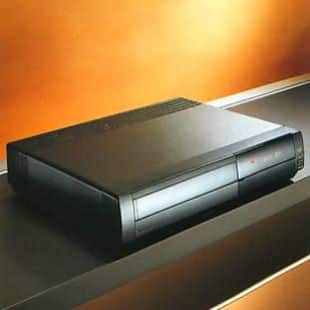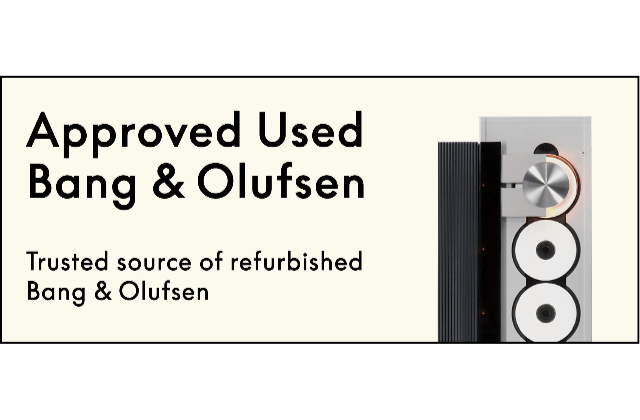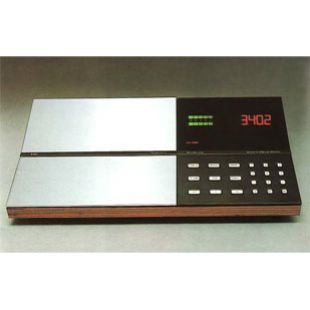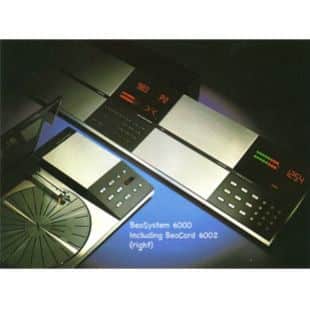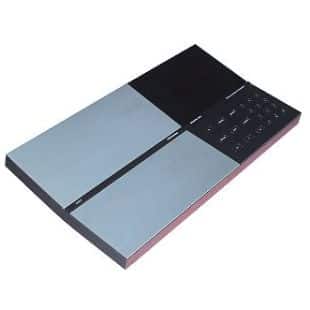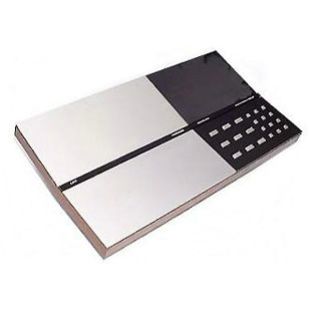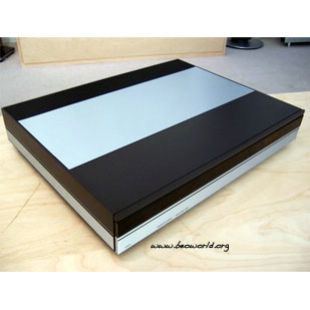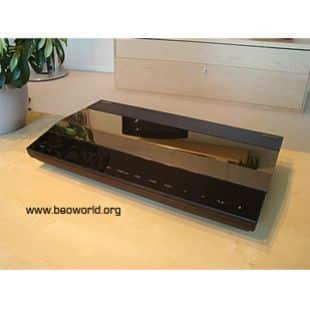While Beocord 9000 shared all of Beocord 8004’s advanced engineering techniques and microcomputer intelligence, its superior sound quality was achieved by the addition of a unique tape calibration system. This computerised system measured the four vital recording parameters of each individual tape – bias, equalisation, sensitivity and distortion level – and actually adjusted the deck’s own recording characteristics to match them exactly.
As a serious recordist, you no doubt had your particular favourites among the many brands and types of cassette tapes available when Beocord 9000 was released. And your particular hates too! Good results are partly a measure of how closely the tape’s technical characteristics match the ‘average’ recording parameters for which your machine is adjusted during manufacture. The tape brand you have identified as ‘the best’ may, on another type of recorder, sound quite poor. The fact is that tape manufacturers design their tapes for use with as many different recorders as possible, while the equipment manufacturers design their decks to use all brands and all types of tape. So both industries rely on a set of ‘average’ specifications.
But with Beocord 9000 microcomputer technology freed Bang & Olufsen from this hit and miss approach. B&O gave Beocord 9000 the ability to monitor the tape and set its own recording characteristics accordingly, thereby creating a perfect partnership within very fine tolerances.
What is more, Beocord 9000 could show you on a digital read-out panel what those settings were, and could store them in its computer memory. Calibration data for each of the three tape types – ferric, chrome and metal – could be stored in this way.
The tape calibration process was fully automated and took about 9 seconds from the touch of a button. Beocord 9000 featured a new type of Sendust/ferrite tape head, specially designed for Bang & Olufsen. It had separate tone-gaps for recording and playback, housed in a single casing. Compared to a combination head, this arrangement afforded wider frequency response and constantly correct azimuth between recording and playback.
The real-time counter was similar to that used in Beocord 8004 but had an additional feature. Beocord 9000 could calculate and display the time remaining on the tape, as well as the time already consumed. In other respects the operation, facilities and dimensions of Beocord 9000 are as described for Beocord 8004.
Beocord 9000 could be used as a stand-alone tape cassette recorder or as part of Beosystems such as Beosystem 6000 or Beosystem 8000.
Auto-Calibration
With improving specifications of cassette recorders, tape manufacturers also made progress in the formulation of tape. Standards committees decided to classify tapes into three main categories: oxide tape, chrome tape and metal tape. The newer categories allowed improved recording performance, but also required different recording bias levels to achieve the improvements. Manufacturers of cassette recorders incorporated switches to adapt the recording characteristics to the tape, and later a system of slots at the back of the cassette were standardised, so that the recorder was set to the correct type of tape during recording. It should be added that once recorded, replay conditions were identical for all tape types, so that once the cassettes were recorded, they could be replayed on any machine.
While the categories were standardised, manufacturers did not strictly adhere to the standards, in an effort to offer improved performance from their tapes. This meant that bias needed to be set differently for the tapes from each manufacturer, even within each tape category. In addition, the maximum recording level was different for each tape category, and for tapes within each category. As if this were not enough, tapes from any particular manufacturer also proved to be slightly variable from time to time, and from batch to batch. This meant that for the best recording performance, not only that bias needed adjustment for every single tape that was used, but that the level meter also needed calibration to show the optimum maximum recording level.
To take these factors into account and allow the best recording on tapes of all types and manufacture, Bang & Olufsen decided to incorporate auto calibration in its top-of-the-line cassette recorders. Operation had to be as simple as possible in order to allow maximum performance even for those who were not technically-minded. Finally, a system was developed where the user needed to press a single button, when the recorder automatically performed the calibration and set itself to be ready to record. The recorder remained adjusted for the tape until it was removed from the recorder.
The auto calibration process worked as follows:
* The position of the tape is noted and “bookmarked”
* Under microprocessor control, a short passage with a number of frequencies is recorded on the tape
* The tape is wound back to the original position
* The recorded frequencies are played back and analysed. The analysis gives the microprocessor information about the correct bias and the maximum recording level
* The bias is set for the optimum frequency response
* The recording level meter is set to turn on the red warning lamp at the maximum level to which the tape may be recorded without overloading
* The tape is wound back to the bookmark so that the test tones are erased when a new recording is made
* The level recorder is switched to show the level of the input signal to allow level adjustment
* The recorder is set to start a new recording at the touch of the record button
Magazine test:
Beocord 9000
There’s a story behind the development of this remarkable cassette deck and it’s one and the same time a sobering one, highlighting our lack of understanding of what we fondly believe are well-understood physical processes; and something of a fairy tale – albeit of the modern, technological variety.
If there is one outstanding characteristic of the Beocord 9000 that stands out above all others, it is paradoxically its all round balance in every area of performance. The tape mechanics no less than the computerised tape‑handling facilities, have been thoroughly thought out from scratch and the same applies equally to the ergonomics and the signal-handling electronics of the beast. There is literally no sign of the usual commercially inspired compromises that ensure that the most brilliant pieces of laboratory work come out as shadows of what they could have been.
In my opinion, this is simply because B&O have made the decision to pursue a specific requirement for an up‑market recorder in all its facets, without letting their marketing department bend the project towards an imagined maximum public acceptability. The result may be the finest up market cassette deck made, it is certainly the most practical and nicest to use. The price to be paid for all this is heavy – £675 in fact, but in my judgement this is as inevitable as it is justifiable and the recorder remains good value.
The story referred to relates directly to the Dolby HX Pro circuit used in the B&O, a circuit that was developed by B&O, is marketed by Dolby Labs (hence the name) and will be seen on a wide range of cassette decks from all sources as soon as B&O’s arranged year of grace has elapsed. According to the company, HX Pro had its genesis when they built an automatic adjuster/tester for the cassette deck production line.
This machine was intended to optimise record bias, equalisation and tape sensitivity adjustments on each machine down the line, and as part of this function it was to feed several frequencies at different levels simultaneously onto a tape, which would then be played back for measurements. When the machine was tested, it was found that the readouts from measurements were different from the predicted values, sometimes by as much as 10dB, a very significant amount.
It soon became apparent what was happening. The signal, especially that at high frequencies, was itself partially biasing the tape and when high levels of high frequencies were recorded, the effective bias current was high enough so that the tape was severely over biased, and high frequencies significantly suppressed. In effect, the self-biasing effect was making a signal dependent compressor out of the mechanism of recording itself. Once identified, the solution was easy enough and the HX Pro circuit consists of just a couple of ordinary op‑amps and a few other components, which have the effect of altering the bias fed to the record head so that the effective (or dynamic) bias stays constant. This contrasts to the situation with every other tape recorder, where only no‑signal (or static) bias stays constant.
I said above that HX Pro is the only system that keeps dynamic bias constant However, the original Dolby HX circuit had many of the same properties. But the facts are that while Dolby HX restores some of the dynamic range available on cassette tape that is otherwise lost by the automatic compression mechanism referred to above, it does so in a convoluted fashion with for example a control signal derived from a Dolby B circuit, and is simply not as effective. In addition, the Dolby circuit is mono, where the B&O circuit, which works quite independently of any noise reduction circuit in the system, is a true stereo device, operating quite independently on each channel.
Now let’s look at taping from another angle. The history of improvements to tape formulations has been a dramatic and rapid one over the last ten years, but has been characterised by one common factor The coercivity and bias requirements of the best available types, has progressively increased with the years. Raw measurements of such tapes dynamic range – the chrome slot and metal ones in particular shows them to have improved performances at the top end of their operational envelopes – that is higher frequency saturation has been less of a problem and because signal/noise ratio performance of tapes is critically dependent on what happens at high frequencies, they have shown a greater effective dynamic range. But this doesn’t explain why such tapes invariably sound sharper more dynamic and clearer than ordinary ferric tapes even on material which lacks any great measured dynamic range.
B&O findings do explain this fact Quite simply, what is happening is that because the signal is much smaller compared to the bias signal on such high energy tapes, the amount of compression caused by the mechanism explained above is reduced. And that’s it. The extraordinary thing is that all the facts here have been well known for many years, but no one seems to have put two and two together and made an effective circuit to eradicate this distortion producing mechanism. Now that it has been done it turned out to have been a small, European company, with no great reputation or special involvement in tape machines which has made the discovery – which in its way is akin to discovering the audio equivalent of the wheel.
To summarise then, the advantage that HX Pro gives is to restore the inherent high frequency dynamics to material recorded on low-bias tapes. The circuit requires no lining up and can be used in addition to Dolby or any other noise reduction system and gives an effective increase in high frequency headroom of up to 10dB on cooking ferric tapes, reducing on high-bias tapes. In effect, HX Pro should make the type of formulation used more or less immaterial, so that the choice can be made on other more important grounds – like the uniformity and finish of the tape coating and the quality of the tape mechanics.
To make the freedom of tape choice point even stronger, the 9000 has an automatic tape calibration system on board, which sets bias equalisation and sensitivity. In contrast to other such systems, the B&O operates very quickly (never more than about nine seconds) and, it seems, very accurately. The sensitivity is set by measuring the inherent distortion of the tape itself, and setting +5dB on the meters to correspond to five per cent harmonic distortion, which puts OVU at 2 ;0.2dB in theory. In consequence, there is no need for the wide ranging meters most metal equipped recorders have, and the OVU point really is near the limits of all types of tape – even those which have a lot of headroom above the normal OVU point, which is usually 200nW, but which may correspond to only half per cent or so distortion. So a couple of button pushes, and any tape should be properly catered for.
Of course, the B&O accepts all normal tape groups, sensing the type inserted by the lugs on the backs, but there is an override switch, and in any case, the lug sensor is ignored by the calibration process should the latter discover the tape to have characteristics inconsistent with what the lugs say. The sensor only controls playback equalisation and nothing more. One small additional refinement is that the recorder will store the characteristics of up to four types of tape if so required, thus bypassing the calibration procedure. But this is only the beginning. The 9000 is equipped with a small built in computer, with 41k of RAM and 2k of ROM and in this relatively small amount of processing space B&O has managed to cram in a number of quite sophisticated programs which can operate on the transport as well as the bias, EQ and so on needed for record calibration. Space is insufficient to detail all of them, but a few examples will give the flavour, as well as explaining some of the capabilities of the machine.
Example 1
The record calibration sequence outlined above. As part of the calibration ‘package’, the programme will identify the leader and wind on to about one minute into the tape. Its job done, it will rewind, then go forward to the end of the leader to wait for the command to start recording. Further, if the tape gives anomalous readings, it will repeat the procedure up to three times at different places on the tape and if still in doubt it will set an average value for the type of tape identified by the lugs at the back of the cassette. The calibration signals are short pulses, spaced 0.5dB apart i.e. logarithmically. The recording done and the tape then passes the replay head about 80ms later, by which time the recorder has switched to replay: and this is repeated until all the required values have been identified. The machine can, if required, be ‘interrogated’ to determine what settings it has chosen.
Example 2.
The prime method of locating tracks is by using a counter scaled in minutes and seconds. The recorder will measure tape thickness if so instructed, by timing the slowing down of the tape-up spool as its diameter increases with added tape – but it does this using just a few turns only. From the tape thickness, the tape length can be inferred and when the end of the tape is neared in record mode, warning is given. It does all this with extraordinary precision, and another even more complex programme comes into play to get the same end result should a tape be inserted which has not been fully rewound.
Example 3.
You can ask the recorder to commence play at, say 12 minutes and 25 seconds into the tape. It will seek out this spot with a repeatability of about one second per 45 minutes playing time and switch to play, but with the output muted, just a few seconds before the required spot. It then looks for a gap between musical segments, and stops in the gap when found. If there’s no gap, it simply carries in to the 12 min 25 sec point.
Example 4.
The record head is demagnetised at the end of each recording, automatically. The playback head doesn’t require demagnetising.
Example 5.
The recorder will find the beginning of the last recording made with just one key operation – and will switch itself into standby (effectively off) after a period of inactivity, Memory contents are protected from unplugging from the mains by a built-in lithium rechargeable battery.
And so it goes on. As noted above, this is a three head recorder, but there is no facility to monitor off-tape, which the head construction chosen would have meant certain compromises to performance according to B&O The reason for two heads is simply to optimise the record and playback heads for their own tasks and to facilitate the record calibration sequence.
Noise reduction systems available to the user are Dolby B and Dolby C – with switchable MPX filtering to protect the frequency response of Dolby recordings. Inputs and outputs are via DIN socketry, but the levels are adjustable between true DIN and normal phono type levels and the output can be continuously varied. The HX Pro circuit is permanently connected, which is sensible enough given its function.
In practice, the results from the recorder will be dependent on partnering equipment, to an even greater extent than usual because the machine itself is so inherently good. The listening was done using the best hi‑fi system at my disposal: a Linn/Naim/Linn Sara one. Pre-recorded tapes sounded as good as I have ever heard them – the ability to be able to adjust azimuth easily helped here, but even at their best such cassettes are rather poorer than records – good records anyway. Records still give the widest dynamics and frequency responses available in the home, and therefore stress the cassette medium to it utmost ‑ even though some of this extension, in the form of LF rubbish from the record deck, is unwanted.
‘Fine’ here is the operative word. I used a variety of tape types, ranging from TDK D to TDK Metal and some in between, and found that metal gave the best account of itself sounding Iivelier and sharper in musical definition, but without any sings of being tonally bright. At the same time, the gap between the tape varieties was narrower than would have seemed reasonable from any other deck I’ve tried, and anyone wishing to economise with one of the mid-price pseudo-chromes or low bias ferrics will not have to accept much compromise.
I also tried the effect of listening with the two noise reduction systems and without noise reduction at all. Unquestionably the best results were to be had with the Dolby systems switched out, and the signal/noise ratio available was still wide enough to make hiss unobtrusive with most programme material. The differences were similar to the kind of differences found by changing tapes, with the recordings made without noise reduction seeming much livelier and more detailed, and better able to hang on to the very low level ‘clues’ such as the ambience surrounding the musical event on tape. By contrast, Dolby B sounded slightly dried out and lifeless; Dolby C more so, but the sound remained tonally flat and certainly with very low levels of hiss using Dolby C especially. For best results without noise reduction it is advisable to use Metal tapes if possible, because of their better signal/noise performance and for their ability to handle high frequency dynamics.
But even using, say, TDK SA or Maxell UDXLII and Dolby C, there was little of the usual sound signature of the cassette medium. Apart from one errant tape which gave a little dropout near the beginning, there was no noticeable dropout and a superb mechanical performance in such areas as stability, absence of the roughening effects of flutter and so on. Equally, there was little of the lack of tunefulness at frequency extremes, of compressed dynamics or of the usual two dimensional, mechanical sound cassette decks usually impart to the music. The Beocord 9000 must come highly recommended and is the first cassette deck I have heard of which I am temp ted to say that it approaches good open reel tape recorder standards and not just on paper, which cassette decks have been doing for years, but in practice.
Beocord 9000 Test Results
Wow and flutter: 0.1% DIN replay
Sensitivities (for OdB at 1 kHz with TDK metal tape):
line: 73mV
Maximum input (for 0.5% THD at 1 kHz):
mic: 0.8mV
line: 3.5V
mic: 26mV
Comments: will match European and Japanese equipment
Headphones maximum output (for 0.5% THD at I kHz): 4.7V into 600 ohms, 1.2V into 10 ohms
Comments: OK with headphones tried – adjustable output
Output level: 0.87V (for Dolby level 200nWb/m) adjustable
Note: The results area little difficult to compare to those of other machines because the measurements are referred to ‘O’ on the meter but this varies automatically from one tape formulation to another in the B&O 9000. For ‘0’ level responses the results below 30Hz are suspect because the input caused clipping at low frequencies.
Source: Adapted from ‘Practical Hi-Fi’ October 1982. Written by Alvin Gold
